#germanic folklore
Photo

Dance of the Wild Men (Wilde-Mändle-Tanz), folk ritual in southern Bavaria involving thirteen men in costumes made from moss found only in the Allgäu Alps
2K notes
·
View notes
Text
The Wiuwert treasure
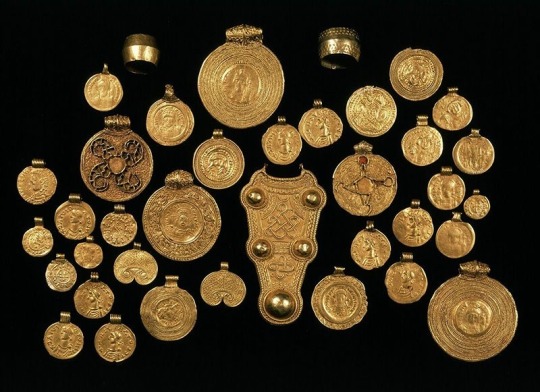
The Wiuwert/Wieuwerd treasure or hoard was found in a terp in modern Frisia.
The hoard was found in a little ceramic jar and contained the footplate of a bow brooch, two disc brooches with cloisonné, two “kidney brooches”, two finger rings, three bracteates and pendants.
These pendants were coins turned into jewelry. Their origin came from all over; Constantinopel, Ravenna, Viviers, Arles, Marseille, Sevilla and Maastricht. They are dated from the 6th and 7th century. It is assumed that the other jewelry was made from melted coins. The find itself is dated around 630.
No human remains are associated with the hoard. Most likely they belonged either to a gold smith or a local leader.
Rijksmuseum van Oudheden, Leiden - The Netherlands
Found in Wieuwerd, Frisia - The Netherlands
#frankish#merovingian#viking archaeology#archaeology#carolingian#charlemagne#field archaeology#viking mythology#merovingian archaeology#germanic mythology#norse mythology#anglo saxon#field archaeologist#frisian#viking#vikings#germanic#germanic folklore#germanic archaeology#odin#wodan#anglo saxon archaeology#history#jewelry#norse
284 notes
·
View notes
Text
The Glöcklerlauf is a tradition practiced in the Salzkammergut region of Austria with pre-Christian roots. This parade of Glöckler (“bell-ringers”) who carry bells and large, lit-up caps marks the end of the Rauhnächte, the darkest and most dangerous time of the year. This parade of art and light chases out the evil winter spirits and ushers in a new season of good and light.
In my town, these Glöckler run 8 kilometers through our neighborhoods, and the caps they carry weigh around 14 kilos. The run takes about 3 hours to complete. The caps represent local landmarks, stories, and even biblical scenes. They’re handmade and passed down for many years.
Food, drinks, and donations are given to the Glöckler to thank them for protecting our villages by ushering in light. This is my second favorite winter tradition here! It’s much more gorgeous in person.
#original#Austria#alpine tradition#folklore#folk magic#witchcraft#germanic folklore#home#salzkammergut
224 notes
·
View notes
Photo

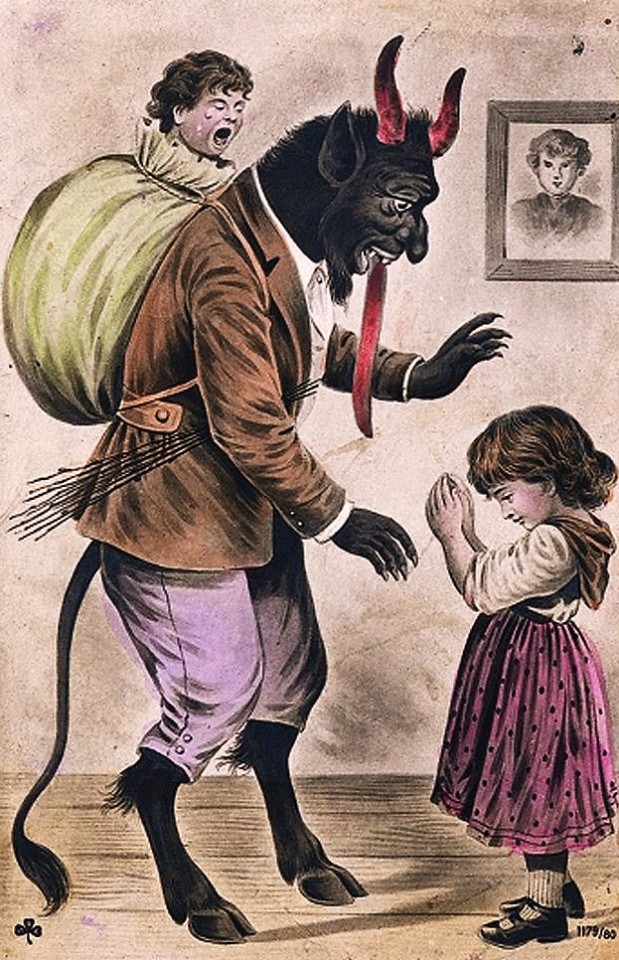

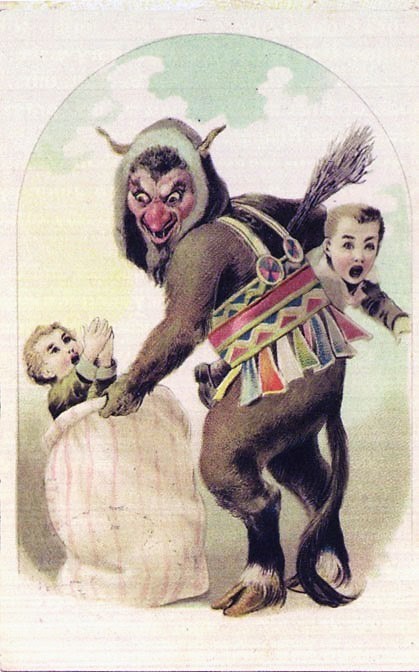
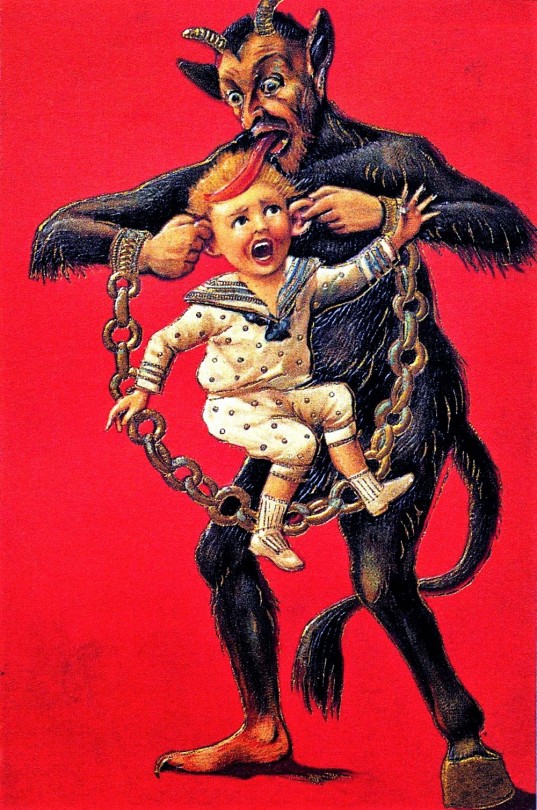
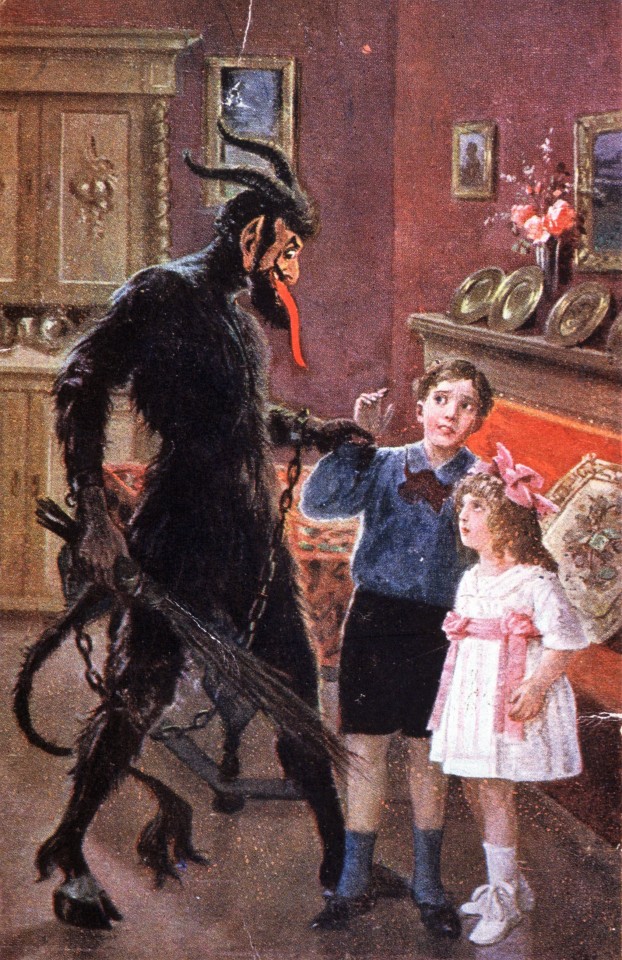

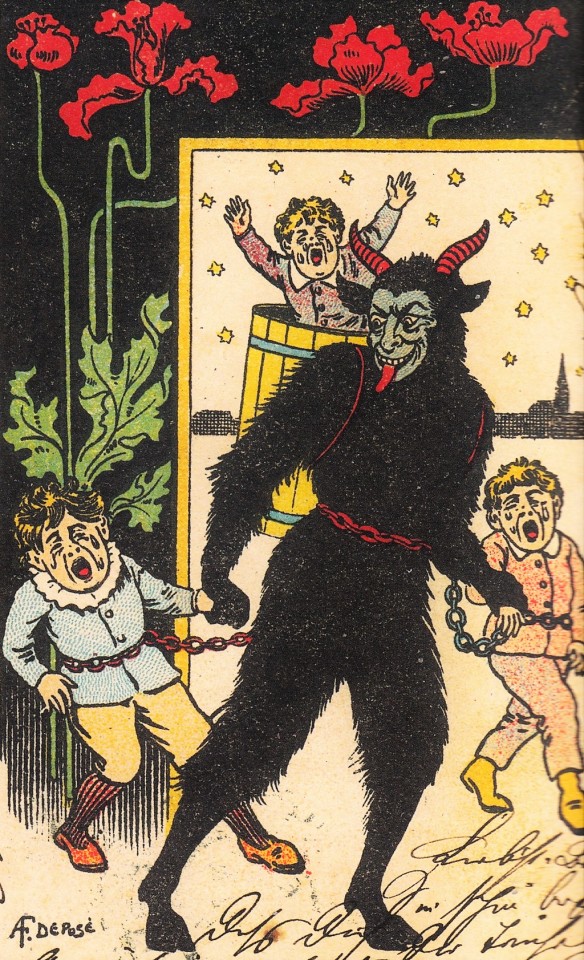
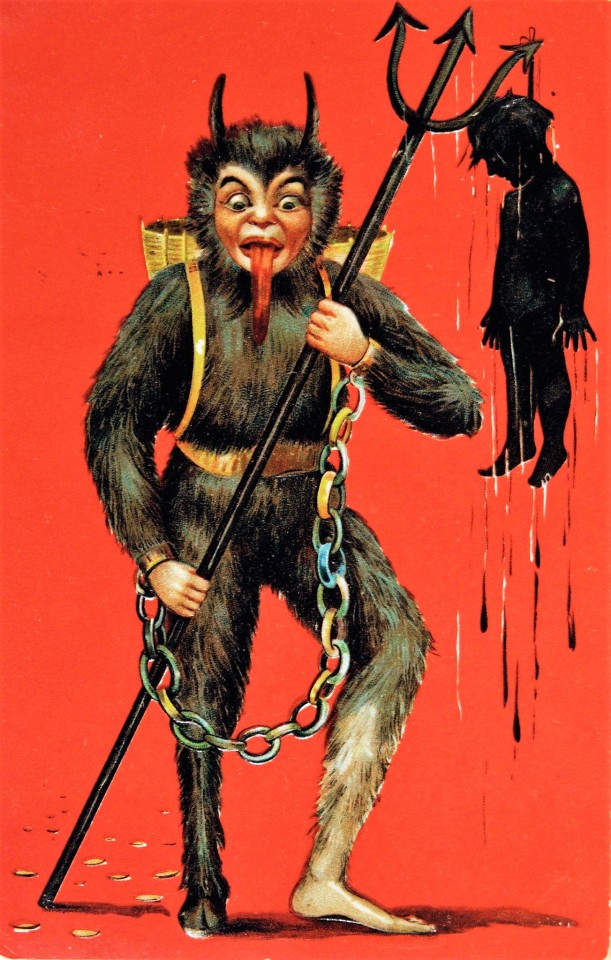
Greetings from Krampus
#krampus#krampus art#vintage illustrations#christmas art#christmas folklore#alpine folklore#krampusnacht#germanic folklore#advent season#supernatural#devil#pagan#greetings from krampus#19th century art#1910s
712 notes
·
View notes
Text

Loki breaks free at the onset of Ragnarök (by Ernst H. Walther, 1897)
84 notes
·
View notes
Text

He lures them with promises of taking them to his homeland. He says it will be a time full of joy and fun.
#BriefBestiary#bestiary#digital art#fantasy#folklore#legend#myth#mythology#monster#fae#fairy#elf#elf king#king of elves#germanic folklore#german legend#erlking#erlkönig#alder king
118 notes
·
View notes
Text
Love German folklore cuz its literally just "if you don't eat all your beans like a good little boy, ChildMuncher is gonna come into your room at night, eat all your fingers and toes, dump you in the woods and replace you. And he eats his beans so we'll like him more."
And on the opposite end of the spectrum we have "Oh this guy? Yeah just give him a beer and he'll go away"
21 notes
·
View notes
Note
What do you know about kelpies? And other creaturea like them?
The sheer amount of information there is about Kelpies has filled entire books, and to include in the discussion all the other variants of water dwelling beings who drown their victims would be a scholarly pursuit that would last lifetimes.
However, I shall attempt to give you a place to begin with.
Kelpies are a kind of water spirit that in Scottish Folklore was thought to inhabit lochs. Loch was a word which meant lake or sea-inlet in Scottish Gaelic, though some lochs could also be referred to as firths, fjords, estuaries, straits, or bays depending on the exact nature of the body of water. These lochs, when they were connected to the sea, could be saltwater or freshwater.
These water creatures are traditionally described as being a kind of horse, which is often black. There was one particular story involving the equine spirit from the River Spey in Scottland who had a white coat and would lure victims on its back with its song. Another version, this time from Aberdeeneshire, a council area in Scottland, depicted the Kelpie as having a mane of serpents.
However in many stories Kelpies are thought to have the power of transformation. They can often take the form of humans in order to complete tasks or lure in victims. One such story depicts a kelpie in the guise of an old, wrinkled, grey haired man who is sitting on the edge of a dyke and mending his trousers. A knock on the head from a knowledgeable passerby caused it to return to its horse shape and flee into the water. Other stories depict the kelpie as taking the form of a rough and shaggy man. A folktale from Barra, an island in the Outer Hebrides in Scottland, actually depicts the Kelpie transforming into a young and handsome man in order to woo a human girl into being his wife. Amusingly, this doesn't work quite as intended when the girl recognizes it as a kelpie and removes its silver necklace which turns out to actually be its bridle. Trapped in its equine form the kelpie is taken to the home of the girl and put to work for a year for her father. At the end of the year, she returns the silver bridle and asks if it would prefer human form or horse form, to which the kelpie asks whether she would consent to be its bride if it took the form of a man permanently, she agrees and they are married.
Very few stories of the Kelpies actually depict them as women, though one rather notable one set in Ross and Cromarty in Scottland mentions a tall woman in green, with a rather disagreeable expression and a somewhat "withered" body, who jumped out of a stream to drown a man and a boy.
A common way to detect a transformed Kelpie was to look for something that gave away its true nature, such as having water weeds in its hair.
As mentioned before, there are some items that are associated with Kelpies in Folklore, the most notable of which is its tack (saddles, stirrups, bridles, halters, reins, bits, and harnesses). Stories involve Kelpies who are captured with a halter stamped with the sign of the cross and put to work pulling heavy millstones or other hard manual labor, something which the Kelpies were notoriously unhappy about. One example is a tale in which the Laird of Morphie forced a captured Kelpie to help build his castle, and upon its release it cursed the family with a rhyme.
"Sair back and sair banes
Drivin' the Laird o' Morphies's stanes,
The Laird o' Morphie'll never thrive
As lang's the kelpy is alive"
(Sore back and sore bones
Driving the Lord of Morphie's stones,
The Lord of Morphie will never thrive
As long as the kelpie is alive)
Other Kelpies were said to already appear with bridle and saddles while in horse form, appearing ready to ride, but upon having a person seated in the saddle they would then dive to the bottom of the nearest body of water and proceed to drown and eat their victim. Some stories depict Kelpies who already possess a bridle who can be exorcised or trapped by removing it. My favorite bit of folklore from these types of stories involves a bridle removed from a Kelpie that has the power to transform anyone else into a pony or horse if it is brandished at them.
On pages LXXXV-LXXXVI of the introduction of "The Popular Tales of The West Highlands", as orally collected and translated from Gaelic by J. F. Campbell , I found that Campbell had gone into an overview of exactly how prominent horses seemed to be in these Gaelic tales. Not only are they plentiful in the tales as ordinary but loyal steeds, there are accounts of people being transformed into horses, horses that have magical abilities or attributes to them, horses which appear as the object of riddles, horses that are given as rewards or prizes, heroes who can take the form of a horse, people who can appear as horses and then turn into men, a horse which in one tale is (oddly) to be hanged as a thief, and horses who can grant wishes. Campbell noted that tales of the Water Horses especially seemed to depict them as being some degraded god, the tales of Kelpies describing them as some kind of river or water god reduced to a bogle (A Northumbrian and Scots term for a category of ghosts or creatures that are known to lure humans to death, unsettle them, or haunt areas) or fuath (a class of malevolent spirits in Scottish Highland Folklore).
Now it is time to look at some of the other beings who are closely related to or similar to the Kelpies. First of these is the Water Horse. Originally this term was used to describe Kelpies themselves, and later expanded to be a general nickname for all kinds of lake monsters and the occasional sea monster. Additionally the term Water Bull has also been used for either Kelpies or Water Horses. Interestingly there are those who attempt to specify the terms Kelpies and Water Horses as referring to beings who dwell in either still water as in lochs, or moving and turbulent water as in rivers and waterfalls. At other times the terms are counted as being synonymous, which causes no end of confusion. Water Bulls, on the other hand, not only is used to refer to the other two groups, but also has a history of referring to an actual bull like creature who can mate with ordinary cattle yet still possesses the amphibious and shapeshifting abilities of the kelpie, as well as being generally considered less dangerous.
A similar horse-like creature is the Nuckelavee, a demon from Orcadian Folklore that cannot abide freshwater but instead lives in the sea and takes on a rather hellish form when coming on land. It is sometimes described as being similar to a centaur, except that it has two heads (one on the man's body and one on the horse's), no skin, a single giant eye that burns like flame, and a mouth that exudes toxic vapors. It was generally considered to be responsible for drought and epidemics as its breath was thought to wilt crops and sicken livestock among other things.
More common to the large varieties of myths and folklore of the Germanic Peoples, are the Nixie, Nixy, Nix, Näcken, Nicor, Nøkk, Nøkken, Nixe, Nikker, Nekker, Nøkke, Nykk, Näck, Nykur, Näkki, Näkk, Nicor, Neck, or Nicker. Under this variety of names they are all depicted as some kind of water spirit, usually with shapeshifting abilities. Sometimes depicted as dragons or worms, other times as female river mermaids, a horse-like creature called the Bäckahästen and another called the Ceffyl Dŵr.
The Nordic näcken, näkki, nøkk were male water spirits who played magical music from violins which could lure in children, men, or women who they could then drown in lakes and streams. There are some stories that depict these spirits falling in love with humans and living with them, but usually they end with the water creature returning to its own home. The German Nix and Nixe are types of river merman and mermaid that lure men to drown, often conflated with the more bird-like Greek Siren.
Of course, not all depictions of water horse spirits and creatures are dangerous beings. The Nuggle, of Shetland Folklore, is a male creature who is nocturnal and more prone to mischief and pranks than actual harm.
There are also countless water spirits of various kinds who don't have horse-like forms or any specific tie to the Kelpie other than the fact that they drown people for a variety of reasons. A good example is the Slavic Vodyanoy, depicted as a naked old man with frog-like features, green beard and hair, webbed hands, burning eyes, and with algae and muck covering his body along with black fish scales.
62 notes
·
View notes
Text
The Wolpertinger

A creature from German Folklore, this is a very illusive creature that is said to hide within the Forests of Bavaria...
#germany#wolpertinger#german folklore#folklore#mythical creatures#bavaria#bavarian forest#germanic folklore#mythical bunnies#lunawolfewolf#luna wolfewolf#monster hunter#german mythology#Wolperdinger#critters#forest#forest creature
52 notes
·
View notes
Photo
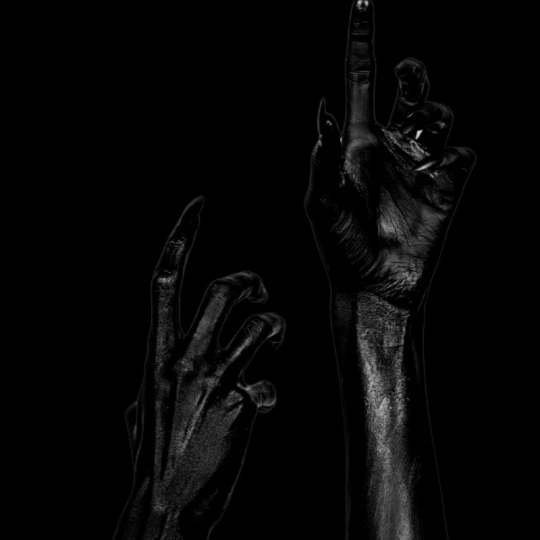
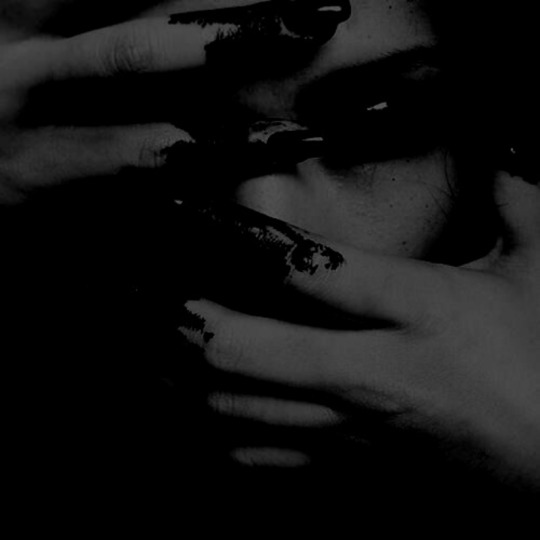
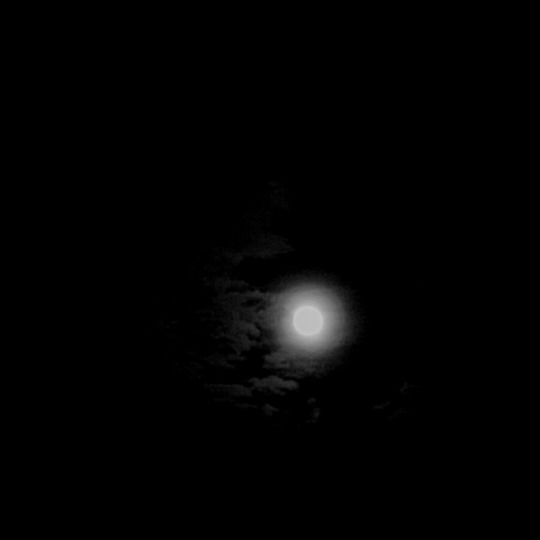






30 days of horror myths: mare
this evil demon causes nightmares by sitting on a person’s chest in the middle of the night. some believe that it enters the room through the keyhole, sits on the chest of the sleeper, and tries to strangle them. to repel it, children are advised to look out the window.
#germanic folklore#germanic mythology#mare#creatures#horror myths#30 days of horror myths#horror#mythedit
147 notes
·
View notes
Text
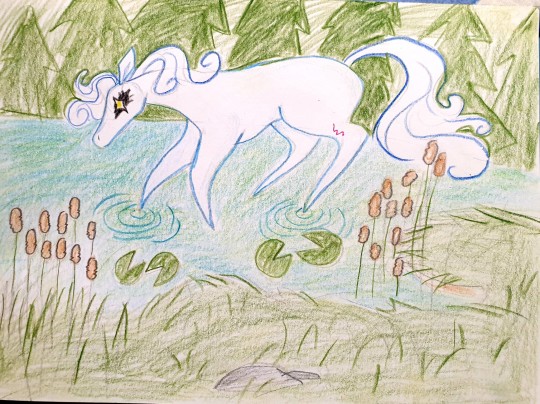
Nøkken ☆ It's true form is a brilliant white horse according to some of the lore!
Please click image for better quality
#art#drawing#nøkken#nykur#nixie#nix#nixy#folklore#fairy tale#fairytales#scandinavian folklore#germanic folklore#monster#horse#mythical creatures
15 notes
·
View notes
Text
The Langobards

The Langobards/Lombards/Longobards are an Italic-Germanic tribe with origins in southern Scandinavia around the first centuries B.C. and A.D.
Their steady migration southward can be retraced by archaeological artifacts, which show their Scandinavian origin.
Their early connections to (the geographical city of) Rome made them very influential in the Western Roman world; on financial, military, religious but also law practice and kingship levels.
The Lombards were quickly christened and were the founding fathers of many religious institutions in northern Italy, ruled Italy, and adapted/adopted Roman Law, making for a culturally rich period. Their capital Pavia is located in the Italian province of Lombardy, named after, you guessed it.
It has to be said (it sounds like a fake fact but is not) that their name means “Long Beards”. In many European languages the descriptive name can be heard in “Langobard” also written as “Longobard”.
Image:
Langobardic radiate headed bow brooch
Found in: Chiusi - Tuscany, Italy
#frankish#merovingian#viking archaeology#archaeology#carolingian#charlemagne#field archaeology#viking mythology#merovingian archaeology#germanic mythology#lombards#Lombardi#lombardia#Lombardic#longobardi#Langobards#norse mythology#anglo saxon#field archaeologist#viking#frisian#odin#vikings#germanic#germanic folklore#germanic archaeology#wodan#anglo saxon archaeology#history#jewelry
137 notes
·
View notes
Text
if anyone has any resources about germanic folk magick or even germanic magick period please share!!
ive been looking for books n such but came up empty handed i think i just don’t know what to search for but please link any resources you have !!
#witchblr#ecletic witch#witchcraft#pagan witch#witches of tumblr#chaos magick#grimoire#germanic paganism#germanic folklore#germanic mythology#germanic magick
23 notes
·
View notes
Text
The Creatures of Yuletide: The Lost Christmas Goddess
This is my last Creatures of Yuletide of the year, so I decided to finish with something huge, an ancient winter goddess that had her feast day exactly on Christmas day and whose influence can still be felt to this day. This goddess has many names and many forms across the Alpine Region, but for sake of clarity, I will refer to her as Holda.
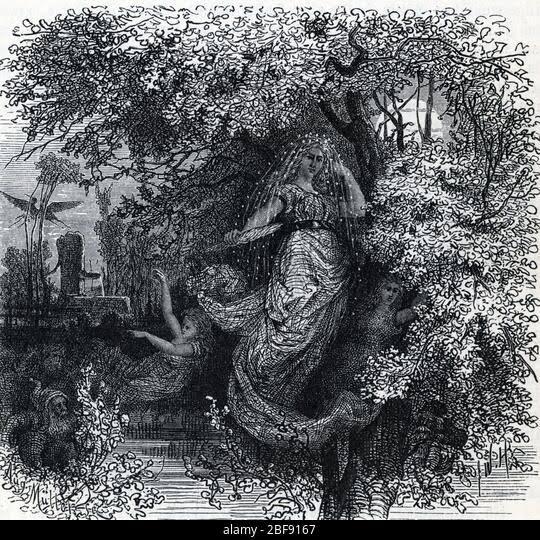
Holda is a figure associated with motherhood, winter, and spinning and weaving. Stories and myths about her spread across Germany, Austria, and Switzerland, usually involving her being both an angelic presence and a demonic force, rewarding the good and punishing the wicked. The anthropologist and archaeologist Marija Gimbutas believes she was the Germanic supreme goddess and is older than the Germanic pantheon, including deities like Odin, Thor, and Loki. She also says:
"[Holda] holds dominion over death, the cold darkness of winter, caves, graves and tombs in the earth….but also receives the fertile seed, the light of midwinter, the fertilized egg, which transforms the tomb into a womb for the gestation of new life."
With the Christianization of Europe, myths and stories about her survived in the countryside and as folk stories.
Jacob Grimm, of the Brothers Grimm fame, in his seminal work 'Teutonic Mythology', described her basic characteristics:
“In popular legends and nursery tales, frau Holda (Hulda, Holle, Hulle, frau Holl) appears as a superior being, who manifests a kind and helpful disposition towards men, and is never cross except when she notices disorder in household affairs. […]
From what traditions has still preserved for us, we gather the following characteristics. Frau Holle is represented as a being of the sky, begirdling the earth: when it snows, she is making her bed, and the feathers of it fly. She stirs up snow, as Donar does rain: the Greeks ascribe the production of snow and rain to their Zeus: so that Holda comes before us a goddess of no mean rank. [...]
Another point of resemblance is, that she drives about in a waggon. She has a linchpin put in it by a peasant whom she met; when he picked up the chips, they were gold. Her annual progress, which like those of Herke and Berhta, is made to fall between Christmas and Twelfth-day, when the supernatural has sway, and wild beasts like the wolf are not mentioned by their names, brings fertility to the land. Not otherwise does 'Derk with the boar,' that Freyr of the Netherlands (p. 214), appear to go his rounds and look after the ploughs. At the same time Holda, like Wuotan, can also ride on the winds, clothed in terror, and she, like the god, belongs to the 'wutende heer.''
The Brothers Grimm also collected a tale about her in which she appears as Frau Holle, and it can be found here. Resuming, an abused stepchild loses a spindle in the well and jumps there to get it back, only to find herself in the magical realm of a kind woman named Frau Holle that has the power of making snow in the real world when she shakes her featherbed pillows.

The girl does the household chores for the old woman and is rewarded by returning to the real world with a shower of gold and the spindle which had fallen into the well.

Jealous, the stepmother sends her biological daughter to try the same, but the girl is so unhelpful that Frau Holle sends her back with a shower of pitch.

Basically, Frau Holle is the female version of Morozko.
Holda is associated with many of the evergreen plants that appear during the Yule season, especially mistletoe and holly, and she had her feast day on December 25, Christmas day.
An early-13th-century text listing superstitions states that "In nocte nativitatis Christi ponunt regina celi quam dominam Holdam vulgus appelat, ut eas ipsa adiuvet.” This text, an Aberglaubenverzeichnis (a common late-medieval and early modern genre), was compiled in the years 1236–1250 by Rudolph, a Cistercian monk. Translating, it states the following:
"In the night of Christ's Nativity they set the table for the Queen of Heaven, whom the people call Frau Holda, that she might help them".
Hulda was known as a goddess of women, which eventually tied her to magic and witchcraft, and she is specifically called out in the Canon Episcopi, written around the fourth century. Those who honored her were required, as faithful Catholics, to do penance. The treatise reads, in part:
"Have you believed there is some female, whom the stupid vulgar call Holda ... who is able to do a certain thing, such that those deceived by the devil affirm themselves by necessity and by command to be required to do, that is, with a crowd of demons transformed into the likeness of women, on fixed nights to be required to ride upon certain beasts, and to themselves be numbered in their company? If you have performed participation in this unbelief, you are required to do penance for one year on designated fast-days.”
Holda was widely mentioned in catalogs of superstitions and sermons during the 15th century, and in the 16th, being equated with other female figures like Diana, and Herodias, the princess that asked for John Baptist’s head.
Her motherhood aspect also is used to link her with the Virgin Mary, and she is the goddess to whom children who died as infants go.
Holiday figures like the witch Frau Perchta from the Alpine Region, and the witch La Befana from Italian folklore, both associated with Epiphany, the feast that celebrates the visit of the Three Wise men, are sometimes linked back to her.
This holiday season, I hope this ancient winter goddess blesses you all and brings a reward for all the good you put out to the world this year. Happy holidays my friends.
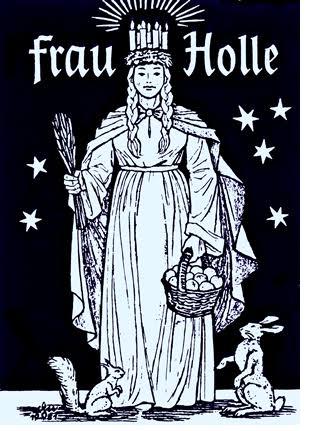
@ariel-seagull-wings @thealmightyemprex @tamisdava2 @princesssarisa
80 notes
·
View notes
Text

There are seemingly endless stories across many different cultures involving visions of a giant black dog. However, it seems as though the tale is originally either Celtic, Germanic, or British. It has since expanded as far as the Americas.
Many say this creature is a manifestation of the devil, or a guardian to lead you into the underworld - but most agree that the dog is in some way or another an omen of death. Despite this grim imagery, there are some that state that the creature itself is generally harmless, and even friendly at times.
Given that this spectral dog spans many cultures, there are many different names given to the creature. Depending on who you ask, he could be "the yeth hound", "huay chivo", "capelthwaite", "gytrash", "oude rode ogen", "cadejo", and/or "dip".
#celtic folklore#germanic folklore#british folklore#south american folklore#central american folklore#latin folklore#american folklore#black dog#hellhound#tw dog#tw death#my post
5 notes
·
View notes
Text
Krampus: The Dark Shadow of Winter
By: Christina McCarthy

While many figures in pagan & witch folklore are shrouded in layers of mystery, some stand out as a little stranger than the others. The more I dig to uncover the true nature of Krampus, the more an ethereal snowy mist seems to gather, further obscuring him into the realm of whimsical Yuletide mythology. Perhaps this is how he’s come to inhabit such a unique place in the psyche of modern people around the world.
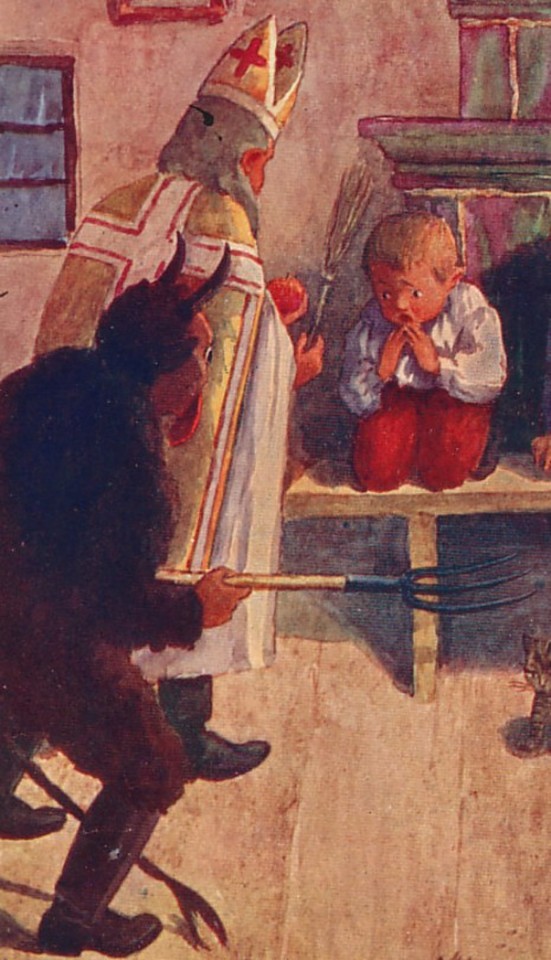
There is debate about how & when the Krampus legend came into being. Some say he’s a sort of pre-Christian deity, the son of Hel, Norse goddess of the Underworld, but evidence for this theory is nonexistent and appears to be a very modern addition to Krampus lore. Other sources say his festival in Germany and throughout Alpine Europe started only a few hundred years ago, a now faded older tradition from pre-Christian Germanic paganism adopted into its modern form by the Catholic church to subdue pagan influences around midwinter. Some classic depictions include chains, to show the power of the Christian god over the “devil”.

This famous depiction shows his one cloven hoof and one clawed bear foot.
Images like these, often featuring poems and season's greetings, come from Krampuskarten, or Krampus cards, often whimsical and humorous greeting & post cards which were exchanged around the holidays, starting in the 19th century. He is often depicted mischievously pursuing beautiful women in a Cupid-like fashion, punishing and chasing weeping children, and accompanying St. Nicholas.
His name appears to come from a combination of a Middle German word, “kralle”, meaning “claw”, and a Bavarian word “krampn” meaning dead, shriveled, or lifeless, connecting him with death mysteries. He is depicted as an often hairy, black or brown, therianthropic beast, part man, part goat, with cloven hooves, reminiscent of the satyrs of Greek mythology. He's also commonly shown with sharp fangs, a red lolling tongue, large bulging eyes, and a single clawed bear foot. There are other regional variations of this spirit, with similar features & mythic function - Knecht Rubrecht and Belsnickel in Germany, Schmutzli in Switzerland, Bartel in Austria, Zwarte Piet or "Black Pete" farther west, and many other midwinter demons. There's even a feminine version - the goddess Perchta lives on today through a similar tradition, Perchtenlauf, where the "ugly" and "beautiful" Perchte or Percht, her hoard of Krampus-like spirits, stage a mock battle in the streets as perhaps a symbolic battle between death and life occurring at midwinter. Some consider this to be a precursor to modern Krampuslauf celebrations, yet the Perchta tradition continues to exist alongside Krampus today.
The widespread prevalence of such similar traditions gives rise to the theory of a class of spirits like Krampus whose names and specific lore vary by local region.

This map shows Alpine Europe - the highlighted area shows the location of the Alps, but of course the Krampus tradition stretches beyond the exact borders shown.
Map source: https://alpshiking.swisshikingvacations.com/where-are-the-alps/
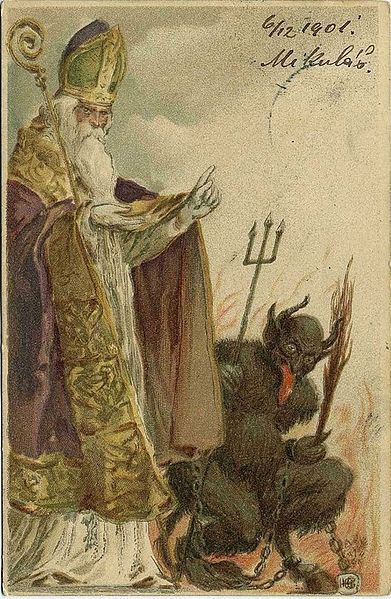
Regardless of his origin, today Krampus strikes a cheerful holiday fright into the hearts of children and adults alike. It’s said that he punishes the children on St. Nick’s naughty list, whipping them with a bundle of birch switches called a "ruten bundle" or sometimes a whip, or kidnapping them in a sack or basket on the eve of St. Nick’s feast day. The punishment is said to fit the crime - the lightest sentence being handed a single birch stick, as if a reminder of which path to choose, and the naughtiest children being dragged to hell or even drowned or eaten by Krampus! Instead of the Christmas Devil's lumps of coal and harsh sentences, good children would find little gifts filling their shoes from the jovial Saint Nicholas, who is often depicted dressed as a bishop with a golden ceremonial staff as pictured above. Sources below have more information about St. Nick if you want to learn more about the minor saint we now call Santa Claus!

In Germanic Europe, holiday festivities in December are first heralded by Krampusnacht, meaning “Krampus Night”, and Krampuslauf, the “Krampus Run”, where revelers dress up in extensive costumes with furs, masks, and horns to run the streets and terrify the townsfolk, inspiring Yuletide nightmares of the Christmas Devil.
This practice may have connection to the pervasive European myth of the Wild Hunt, where dark forces - often depicted as a hunter on horseback and his hounds, among other dark pagan imagery - parade through the skies around midwinter, carrying the souls of mortals over wintery skies to the afterlife. Both Krampuslauf and the Wild Hunt may partly be reminiscent of an ancient cleansing ritual where disguised townsfolk would run the streets, ringing bells and perhaps rattling Krampus's chains, acting as a hellish hoard to scare away unwelcome spirits. To extend the conjecture even farther, some draw a link from Krampus to the witches' horned god, due to his similarity to "wild man" therianthropic figures such as Pan, Cernunnos, and Herne.
Once the children have been sufficiently frightened into another year of their best behavior, the Krampuses traditionally drink alcohol in celebration. The drink of choice, for this after party and for offerings to Krampus, is schnapps. The Krampuslauf tradition is believed to be around 500 years old, and while many attempts to quell these celebrations have been enacted by oppressive forces, from the Catholic church throughout several centuries, to the Christian Social Party of Austria with their famous propaganda pamphlet titled "Krampus Is an Evil Man", to the Nazi Party, the Krampus run is alive and growing today.

From a Krampus celebration in Austria.
One of the most famous festivals takes place in Munich, Germany. Among their famous Christmas marketplace, filled with glittering lights and symbols of Catholic advent, caroling, traditional treats, and the glow of a modern city, Krampuses can be found running around giving folks a chilling holiday scare, reminding them of a time gone by when the fear of winter’s darkness kept everyone warm and safe inside their homes on the eve of December 5th.
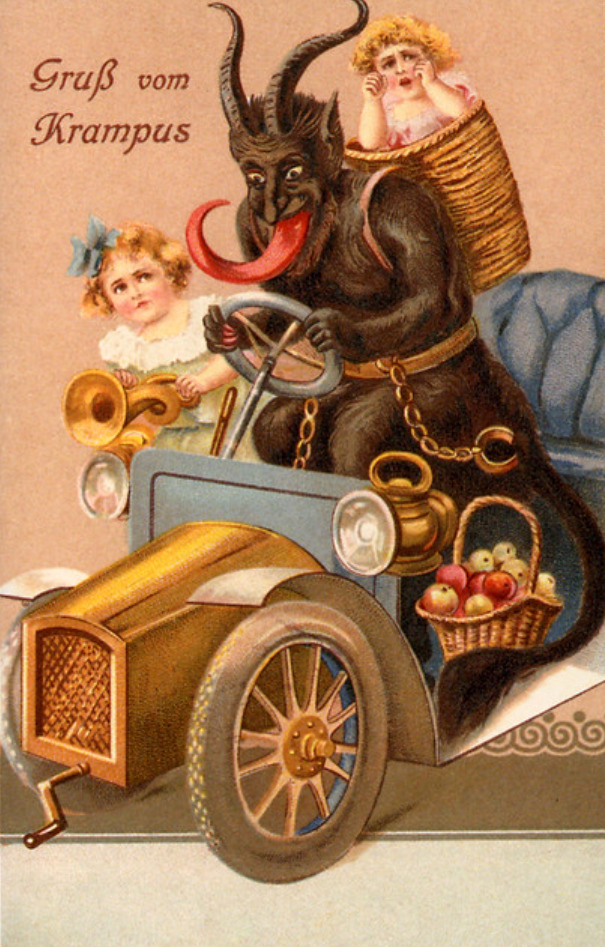
Krampus in a getaway car! We often think of a tradition like this as distant history, so seeing a depiction made during a period of industrialization is a little mind bending!
I personally believe the modern resurgence of Krampus is related to a collective yearning, whether conscious or unconscious, to honor the darkness of the season. What’s become a heavily Christianized (and commercialized) “holiday season” of constant flashing lights and warm familial celebrations, was once more widely regarded as a time of death, darkness, and difficulty. In the depth of winter, when resources and warmth were scarce & daily life was focused on enduring the season, celebrations of the sun were an ode to survival and hope that life would return to the earth again. Krampus represents this inescapable reality of the darkness and hopelessness we experience when the sun is at its weakest, when all the earth holds its breath, silently praying for deliverance from night’s bitter shadows.
Sources:
Note: I'm loosely using Chicago style format, unless there isn't enough information to bother, in which case I will usually just post the link.
🕯️Bustamonte, S. (2018) Krampus Spaß, The Wild Hunt: Pagan News and Perspectives. Available at: https://wildhunt.org/2018/12/the-murky-origin-of-the-krampus.html.
This was an especially rich resource! It contained a lot of detailed information that I’ve never heard before, but most of the new content presented, I was able to verify by looking at other sources. It also lists a book source that seems interesting - books aren’t foolproof, their information should still be verified, but a website listing a printed source is a good sign the information is likely to be correct!
🕯️Krampus. https://brickthology.com/category/banishing/
This was an interesting resource with a wealth of information, which was not sourced and the author seemed to be a random unidentified person, so I still cross referenced the information. This person seemed to have a good working knowledge of the cultural traditions which may be from personal experience, and that kind of information is important in research about regional folklore.
🕯️ https://www.britannica.com/topic/Krampus
🕯️https://www.britannica.com/biography/Saint-Nicholas
For most projects, I use simple pages like these as a starting point for a quick summary of basic information. Brittanica has been around a long time, and I know the information on their site is usually accurate. I still cross-verify the information to make sure there aren’t any inconsistencies.
🕯️Christmas Market at Marienplatz: The Magic of the Christmas Season. Simply Munich. Available at: https://www.munich.travel/en/pois/markets-festivals/christmas-market-marienplatz.
I had some prior knowledge that one of the most popular Krampus Runs takes place in Munich, so I sought out an official Munich website to get their version of the information. What I found was context surrounding Krampus, seating him firmly in modern German customs, and that helps bring mythology to life.
🕯️Krampus, the Christmas Devil of Alpine Europe. The German Way & More. Available at: https://www.german-way.com/krampus-the-christmas-devil-of-alpine-europe/.
I didn’t strictly use this source in this blog post, but I found it to be a credible source that goes further into detail about regional Krampus traditions, containing photos, videos, and further links on related topics. I like to provide sources like this in my bibliographies for people to learn more than what I wanted to cover in the post.
🕯️Perchtenlaufen. https://en.wikipedia.org/wiki/Perchtenlaufen
That's right, this is a wikipedia link! Sure, wikipedia can be unreliable. As long as you're checking the information with other sources, there's nothing wrong with using it as a starting point to break into information you're not familiar with.
All photos with sources not listed are under public domain.
#krampus#krampusnacht#blessed yule#yule log#christmas#christmas traditions#midwinter#winter solstice#modern paganism#pagan witch#folklore#germanic folklore#norse folklore#norse#krampus run#christmas devil#st nicholas#christmas folklore#krampuslauf#paganism#witchcraft#witches of tumblr#germanic paganism#folk magic
49 notes
·
View notes